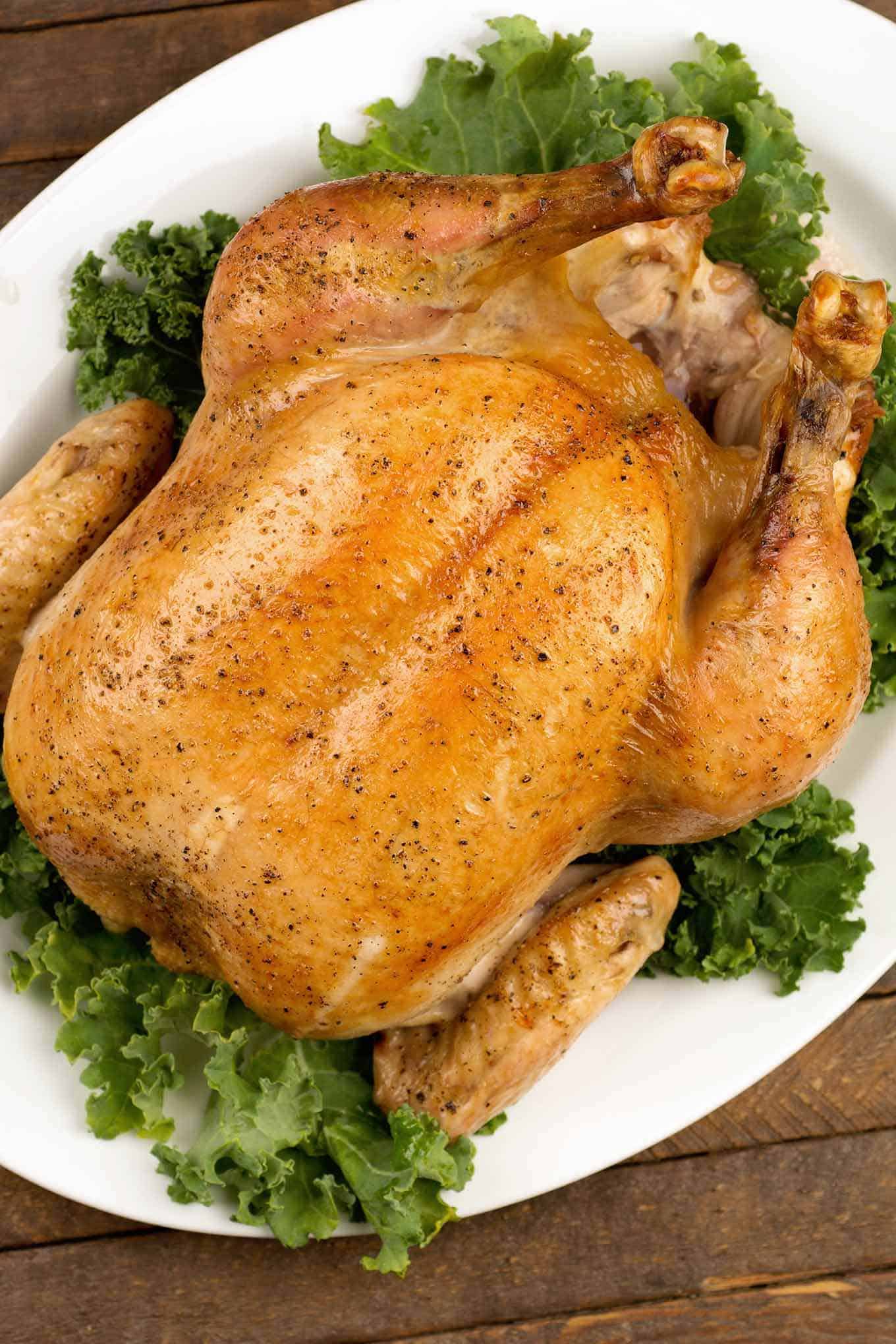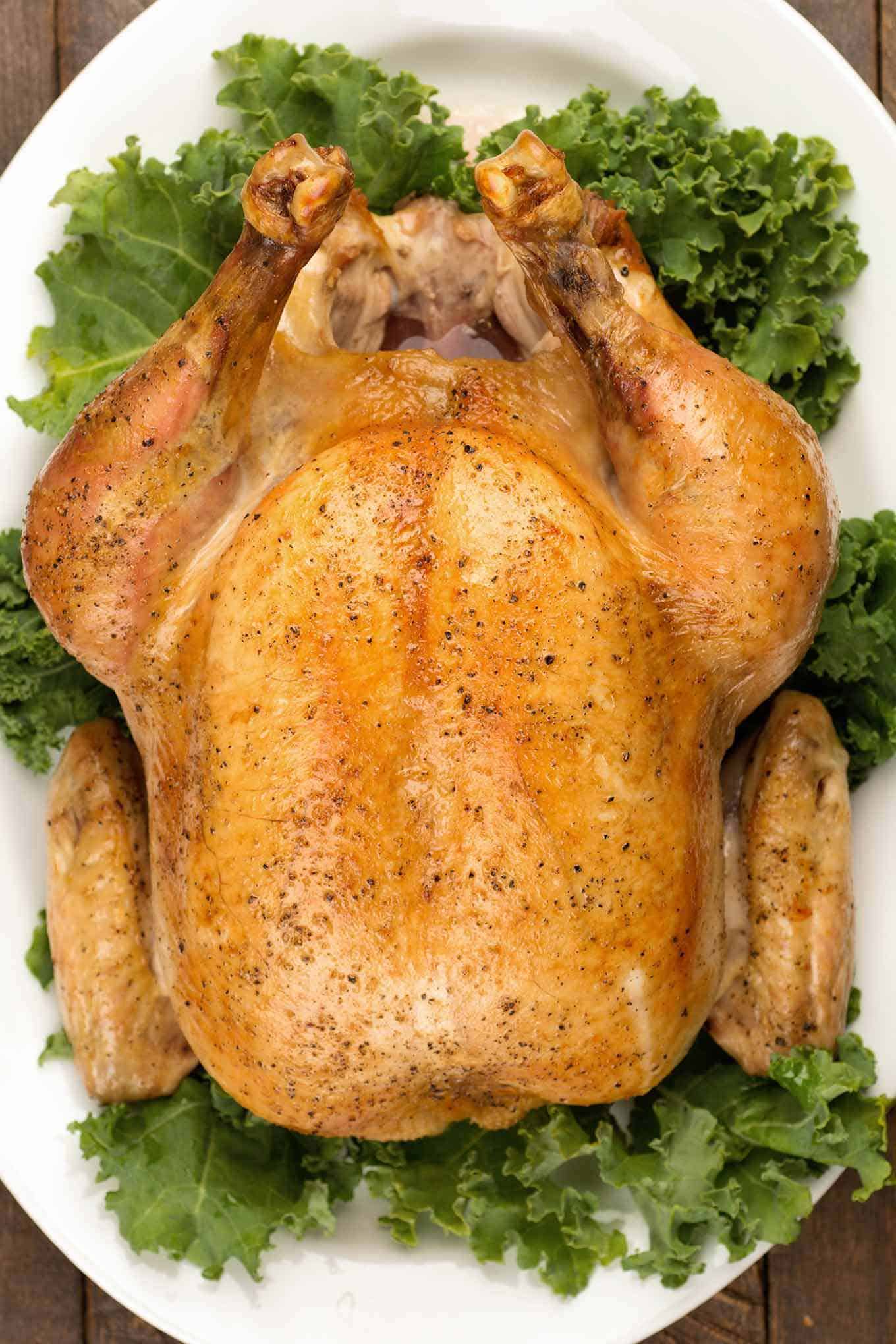This post may contain affiliate links. Please see our disclosure policy.

Larger than a roasting chicken, but smaller than a turkey, capons are tender, juicy, and easy to prepare and carve.
What Is a Capon?
A capon is a rooster that’s been surgically castrated (caponization) at a young age, causing a hormonal change in the bird that improves the quality of its meat. Raised to a weight between 6 and 12 pounds, capons are broad-breasted and juicy with a tender texture and rich flavor that really sets them apart from chicken and turkey.
Look for an all-natural, free-range bird that’s been humanely raised and fed a vegetarian diet without any added hormones, antibiotics, or growth stimulants. If you can’t find a capon locally, we recommend shopping with D’Artagnan. They sell fresh capons during the holidays and frozen capons (in limited quantity) after the season has passed.
How To Make a Roasted Capon
This is an overview of how this dish is made. You’ll find detailed measurements, ingredients, and instructions in the printable version of the recipe below.
- Bring the capon to room temperature before roasting.
- Season the cavity and stuff it with aromatics (onion, carrot, celery, garlic, and parsley).
- Truss the capon with kitchen twine.
- Rub the skin with olive oil and season liberally with salt and pepper.
- Place the capon on a rack in a roasting pan and add a 1/2-inch of liquid to the bottom.
- Start roasting the capon at high heat (450°F), then lower the temperature (350°F) and continue roasting, basting every 15 minutes with the pan juices.
- Let rest before carving.


Roast Capon
Ingredients
- 1 capon, 6 to 8 lbs
- 1/2 small yellow onion, peeled
- 1 medium carrot
- 1 stalk celery with leafy top
- 4 to 5 sprigs parsley
- 2 cloves garlic, peeled
- 1/2 cup white wine
- Olive oil
- Salt and freshly ground black pepper
- Cheesecloth and kitchen twine
Instructions
- Remove the capon from the refrigerator 30 minutes prior to cooking. Preheat the oven to 450°F and coat a roasting pan and rack with nonstick spray.
- Cut the onion into 2 wedges and chop the carrot and celery into 3 or 4 pieces each. Place them in the center of a square of cheesecloth, add the parsley and garlic and gather up the edges to make a bag. Secure with kitchen twine.
- Season the cavity of the capon with salt and pepper, then place the bag of aromatics inside.
- Truss the capon by looping a length of twine under the tailbone and around the ends of the legs, cinching in the center to bring them together in front of the cavity. Fold the wing tips under and position the capon on the roasting rack.
- Drizzle the capon with olive oil and use your hands to rub it in, being sure to get in between the legs and the body. Season liberally with salt and pepper.
- Add the wine to the roasting pan along with enough water to bring the depth to about 1/2 inch.
- Roast the capon for 30 minutes at 450°F, then lower the temperature to 350°F. Baste the capon with the pan juices and return to the oven.
- Continue roasting, basting every 15 minutes, until an instant read thermometer placed in the thickest part of the thigh registers 165°F. Total roasting time (including the 30 minutes at 450°F) for a 7 lb capon should be about 2 hours (17 minutes per pound).
- Allow the capon to rest for 15 minutes before carving.
Notes
Nutrition
Nutrition information is automatically calculated, so should only be used as an approximation.













I have a capon fr tomorrow the problem is I don’t know the weight I do know that it’s quite heavy any thoughts on how I should approach the problem of cooking the bird
Hi Brian,
My first suggestion would be that if you have access to a bathroom scale, simply weigh yourself, then weigh yourself again holding the capon (sans roasting pan of course). This would give you a decent enough idea of how long the bird will take to cook. If that isn’t possible, you’ll need to plan the rest of your meal around a flexible serving time and start checking the internal temperature in the thickest part of the capon’s thigh after 1 hour and 45 minutes of roasting. Let your guests know the earliest possible serving time, choose side dishes that you can keep warm, and have an extra appetizer on hand if the bird takes longer than expected. I’m sure no one will complain.
I will try your Capon for Thanksgiving – as children we enjoyed eating one every yearly was always a family favorite, yum!
I tried a capon for my Thanksgiving dinner and loved it. It’s a great idea for a smaller group and your instructions came in handy. Thanks for the recipe.
Thanks Connie,
Glad our instructions helped.